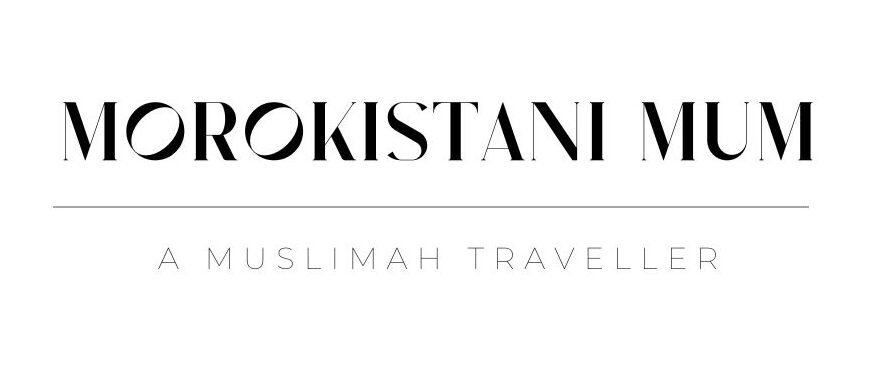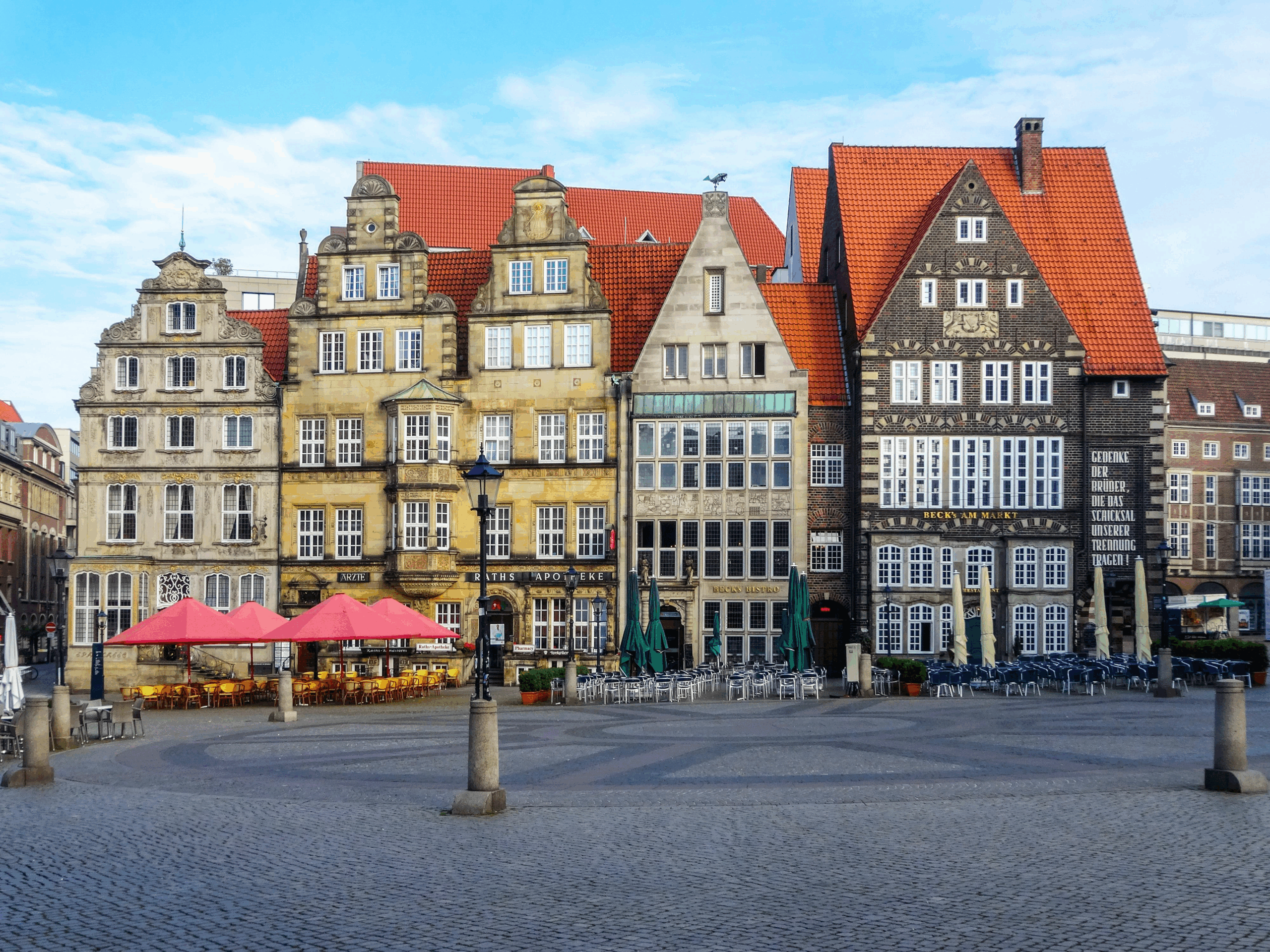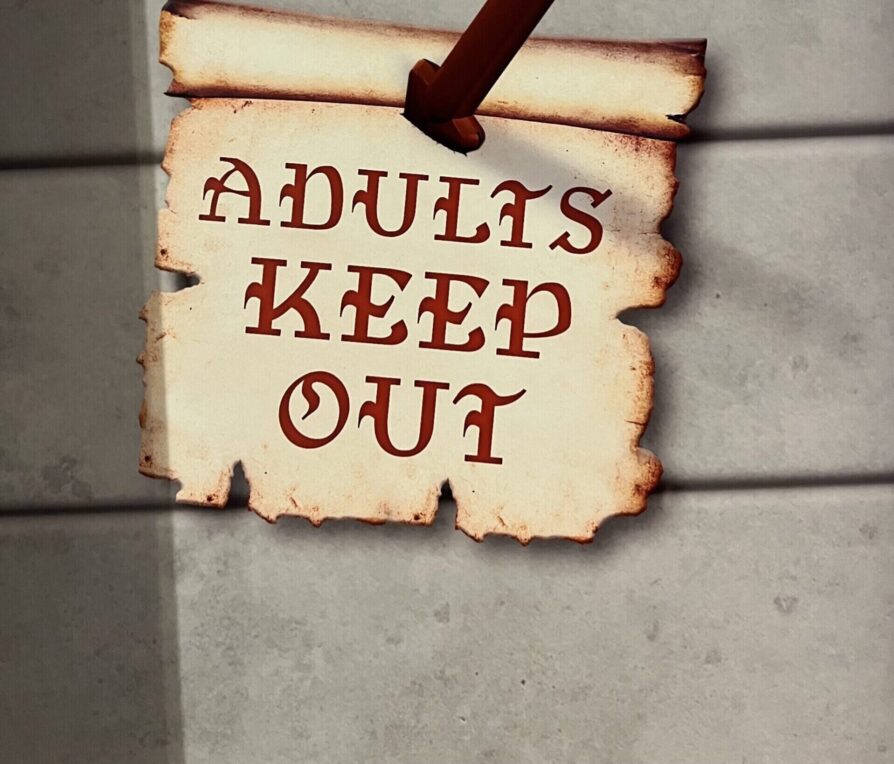Disclosure: This article may contain affiliate links, which means I may earn a small commission at no extra cost to you. Thank you for helping me keep this blog going! 💛
Visiting the Louvre Museum in Paris can be fascinating… and also a little intimidating. With over 35,000 artworks spread across 60,000 square meters (and more stocked away from public eyes), it’s easy to feel lost when entering it.
Having lived just an hour by train from Paris, I used to visit the city often, usually for quiet walks along the Seine and to see my friends. I studied history and art history at university, and after my first year, I even considered applying to the École du Louvre. But I wasn’t confident enough back then to move to Paris alone.
Still, my connection to the Louvre began much earlier. I visited it on a school trip for the first time. Standing in front of the Mona Lisa, I was surprised by how small she was, yet completely fascinated. That day sparked my lifelong love of art.
So, if you’re planning your first visit (or revisiting with fresh eyes), here’s how to experience the Louvre without feeling overwhelmed.
How to Get to the Louvre
Located right in the heart of Paris, by the river Seine, the Louvre Museum is easy to reach by public transport, on foot, or even by boat. Whether you’re staying nearby or coming from the suburbs, here’s how to get there smoothly.
What’s the Nearest Metro Station to the Louvre?
Palais Royal – Musée du Louvre (Lines 1 and 7): From there, you can follow signs to the Carrousel du Louvre, which leads you directly inside through an underground passage.
Other nearby metro options:
- Pyramides (Line 14) – a short 5-minute walk.
- Tuileries (Line 1) – ideal if you want to enjoy a stroll through the gardens first.
Which bus stops at the Louvre?
Several Paris bus lines stop right near the museum: Lines 21, 27, 39, 68, 69, 72, 95. All stop at or near Palais Royal – Musée du Louvre.
Tip: Line 69 is a hidden gem. It runs through some of Paris’s most scenic routes, from the Eiffel Tower to the Louvre. Here is the RATP’s website to check your routes and fares.
Can You Drive or Park Near the Louvre?
Driving in central Paris can be stressful, but if you must:
- The Carrousel du Louvre underground car park (access via 1 Avenue du Général Lemonnier) is the most convenient.
- Open 7 a.m.–11 p.m., directly linked to the museum via elevators.
- Parking costs around €12.50 for 2 hours.
- A discount is available for visitors with disability. Check with the dedicated area for visitors with special needs under the Pyramid.
Where can you catch a taxi?
While the drop-off area is at the Carrousel roundabout, you will find the pick-up area at Place André Malraux.

You can also get to the Louvre by Batobus. The station is only a 4-minute walk away from the museum.
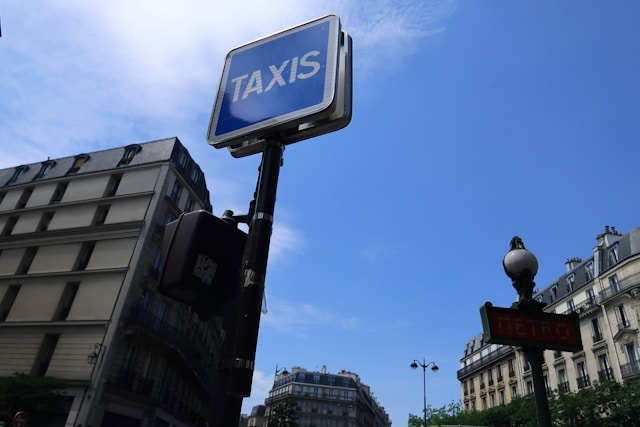

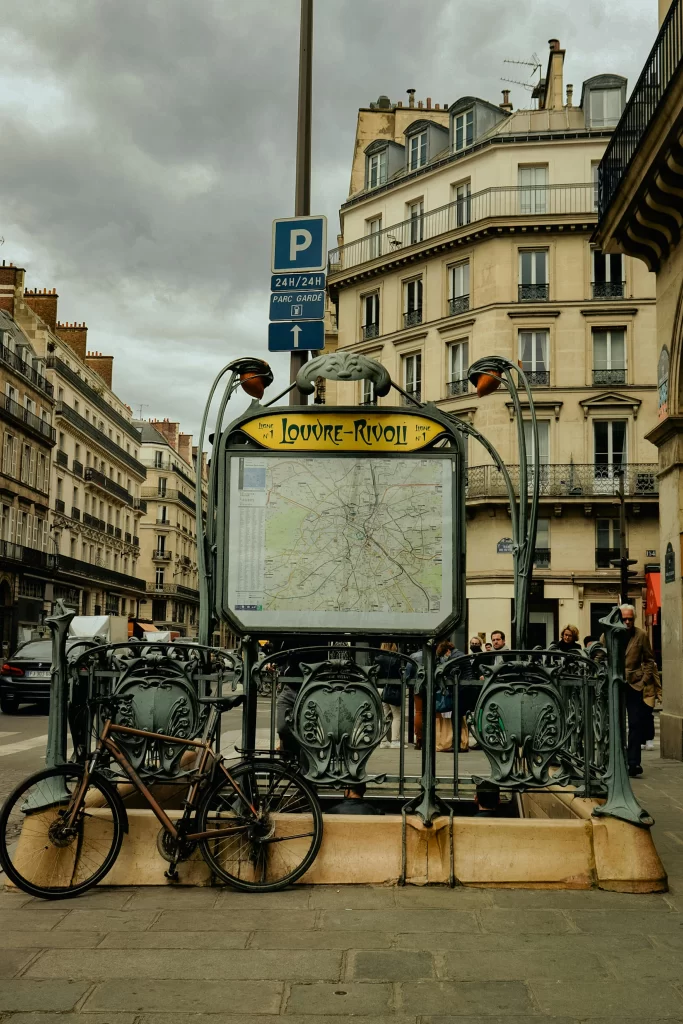

When Is the Best Time to Visit the Louvre?
If possible, avoid weekends, public holidays, and school breaks. These are the busiest times.
What Are the Louvre’s Opening Hours?
Please note that the museum closes at 5 pm on the 24th and 31st of December. The last entry will be one hour before closing time, and the rooms are cleared 30 minutes before closing.
- Monday: 9 a.m. – 6 p.m.
- Tuesday: ❌ Closed
- Wednesday: 9 a.m. – 9 p.m. (late opening)
- Thursday: 9 a.m. – 6 p.m.
- Friday: 9 a.m. – 9 p.m. (late opening)
- Saturday: 9 a.m. – 6 p.m.
- Sunday: 9 a.m. – 6 p.m.
Closed: Every Tuesday, January 1, May 1, and December 25.
What’s the Best Time of Day to Visit?
If you’re planning your visit independently, these are the best windows to explore:
- Morning (9:00–11:00 a.m.) – Best for iconic artworks like the Mona Lisa and Winged Victory before tour groups arrive.
- Evening (after 6:00 p.m. on Wednesdays and Fridays) – Magical atmosphere with fewer visitors and soft lighting in the galleries.
- Lunchtime (1:00–3:00 p.m.) – Tour groups pause for lunch; some rooms briefly empty.
Which Days Are the Least Crowded?
- Wednesday & Friday evenings: Ideal for a calm, almost romantic visit. Locals often come after work.
- Monday & Thursday mornings: Quieter start of the week after the Tuesday closure.
- Avoid weekends & public holidays: Long queues, especially under the Pyramid.
What’s the Best Season to Visit the Louvre?
Each season offers a different mood inside and outside the museum:
- Spring (March–May): Lovely weather, moderate crowds. Great for combining with the Tuileries Garden.
- Summer (June–August): Busy — arrive early and stay hydrated.
- Autumn (September–November): My personal favourite. Warm light, fewer tourists, and calmer galleries.
- Winter (December–February): Quiet, perfect for slow exploration.
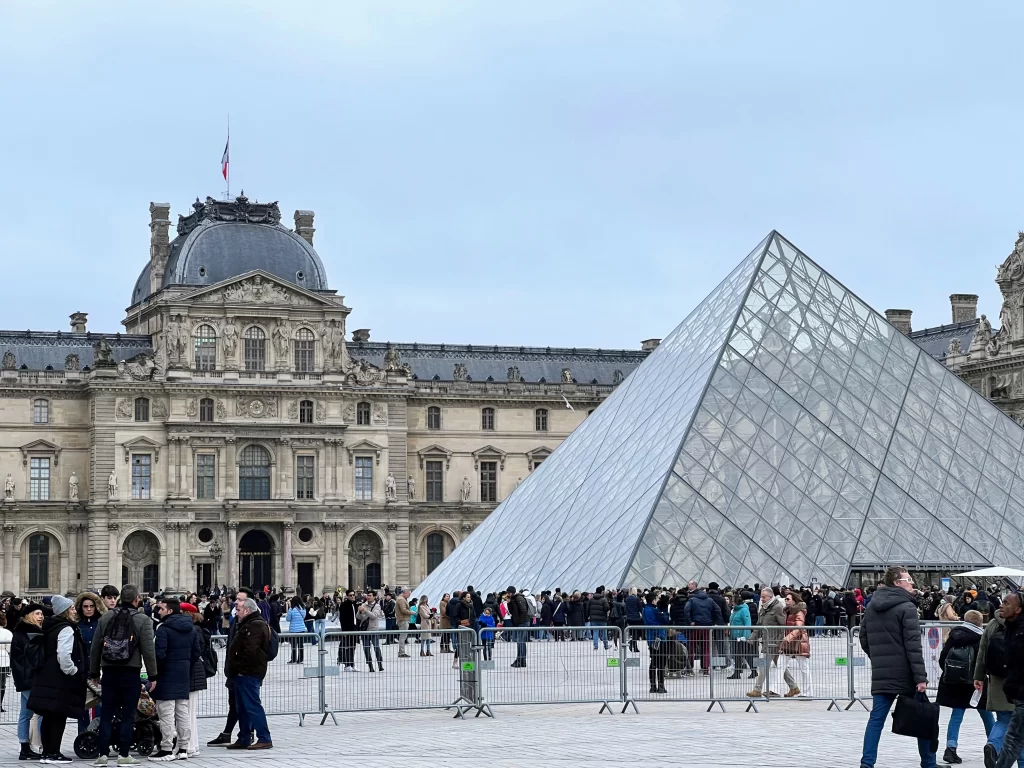
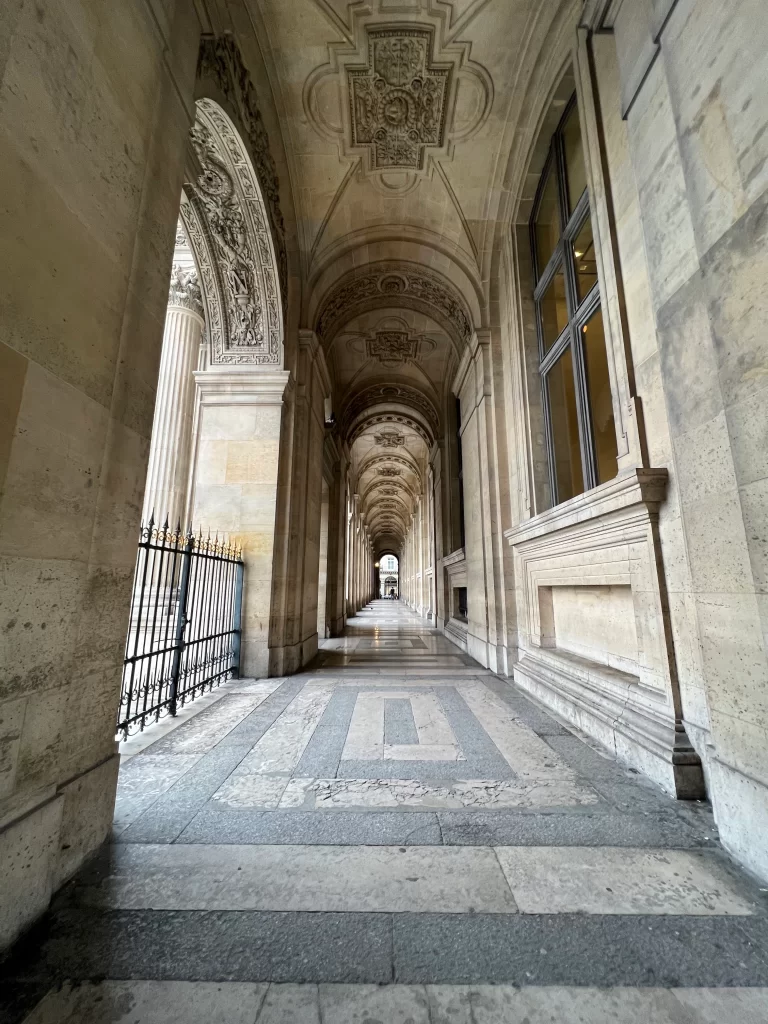
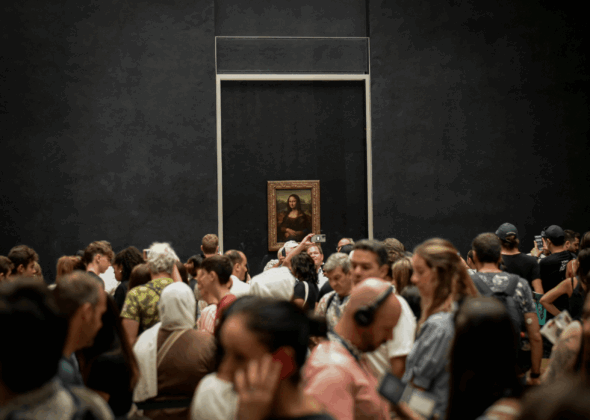
How Much Does It Cost to Visit the Louvre?
A visit to the Louvre doesn’t have to be complicated or expensive. The museum offers different ticket options depending on how you want to explore.
And the best surprise here is that it is free for children. So a family trip isn’t as costly as one would assume. And temporary exhibitions are also included in the price. Entry to the Eugène-Delacroix National Museum on the day or the day after is also included. Now this sounds like a good deal.
Whether you prefer wandering freely, joining a guided tour, or renting an audio guide for a slower pace, there is a budget for everyone
What Are the Ticket Prices for the Louvre?
The ticket prices are the same whether you buy them online, onsite, 3 months ahead or on the day. Personally, I prefer to book a time-stamped ticket online; I’ll still queue, but not as much as if I turn up on the day! Also, there are periods when the Louvre is only available by reservation.
Beware of scams selling “skip the line” tickets (there is no such thing at the Louvre) or resellers of fake tickets on the street.
- Standard ticket (online or on-site): €22
- Free entry:
- Every first Friday of the month after 6 p.m. (except July and August), booking is mandatory.
- Under 18 years old (any nationality)
- EEA residents under 26 years old
- Disabled visitors and their companions
- Art teachers, job seekers, and journalists, etc (with ID proof), check if you are eligible here.
Tip: Always keep a digital or printed copy of your ticket. Security checks are strict, and mobile reception under the glass pyramid can be spotty. Prices and details may change: check www.louvre.fr for the latest.
Are There Guided Tours at the Louvre?
Yes, and they can completely change your experience. I definitely recommend them. Not only will you get valuable knowledge, but it will also help you make the most of your visit by navigating the museum with someone who knows it well.
Official Louvre Guided Tours are available in English and French.
- Price: Around €12 extra or €31 including a museum entrance ticket. €9 for visitors eligible for free Museum entry.
- Duration: About 1.5 hours.
- Themes: “Louvre Family” suitable for over 6s, “Welcome to the Louvre” for over 12s, and “Another Louvre”.
Note that they are subject to changes, and you can check their availability and book them here. If you want to enter the museum before your guided tour, you will have to buy your entry and tour tickets separately.
Is There an Audio Guide?
Yes, the Louvre offers an official audio guide
- Price: €6
- Languages: 3 languages, English, French and Spanish.
- Includes: The permanent collections only.
If you love exploring at your own pace, the audio guide is perfect; you can pause, look around, and replay.
What Add-Ons and Facilities Are Available?
The Louvre is surprisingly visitor-friendly. Whether you’re travelling solo, with kids, or need accessibility support, everything is designed to make your visit smoother.
- Free lockers are available under the Pyramid.
- A map of the museum is available in 9 languages.
- Free Wifi is available for one hour and is renewable indefinitely.
- You can store small bags, coats, or umbrellas — but no suitcases, large luggage
- Wheelchairs and folding chairs are available for free at the information desk.
- Baby carriers and strollers (lightweight models only) are available for free.
- Family-friendly rest areas and changing tables in the studio.
- Cafés and restaurants inside.
Insider Tip: Take a short break at Café Mollien, upstairs near the Denon Wing. The terrace overlooks the “Place Napoleon” and has one of the prettiest views in the museum.
Which Entrance Is Best for the Louvre?
The Louvre has four main entrances, and choosing the right one can save you time, especially in high season. Most visitors head straight for the famous glass pyramid, which has the longest queue.
Pyramid Entrance (Main Entrance)
- Located in the main courtyard, the Cour Napoléon.
- Most iconic but also the busiest.
- Security screening can take up to 30–60 minutes during peak times.
- 3 queues here: Orange for those without booking; Green or Rose for visitors with bookings or Paris Museum Pass; Blue is a priority queue for visitors with a disability.
Carrousel du Louvre Entrance
- Underground entrance via the 99 Rue de Rivoli shopping arcade.
- Direct access from Palais Royal, Musée du Louvre metro station.
- Usually much faster.
- Accessible for visitors with reduced mobility, for groups, Museum card holders, and visitors with a booking.
Richelieu Entrance (for groups & members)
- Reserved for Louvre Pass holders, tour groups, and Amis du Louvre members.
- Much shorter queues if you’re eligible.
Groups of fewer than 7 people can only use this entrance when accompanied by a certified guide.
Porte des Lions Entrance (reopening expected soon)
- Near the Seine River, used mainly for quick access to the Denon Wing (Mona Lisa, Winged Victory).
- Often the least crowded when open.

What Are the Louvre’s Must-See Highlights?
If it’s your first time at the Louvre, start with the Denon Wing; it’s where most of the masterpieces are, from the Mona Lisa to the Winged Victory of Samothrace. Even after years of studying art history, I still return to this wing first.
Where Is the Denon Wing?
Once you’ve entered the Louvre, follow the signs for the “Salle des États” (Mona Lisa). The Denon Wing covers three floors, but the main highlights are on the first floor, accessible by escalator or the grand staircase under the Winged Victory.
The Must-Sees in the Denon Wing
Mona Lisa by Leonardo da Vinci
- Room 711: Salle des États (the largest room of the Louvre)
- Why it matters: The world’s most famous smile, painted around 1503 by Leonardo da Vinci. It was bought by the French king François I in 1518.
- Fun fact for kids: She has no eyebrows! Historians think they faded over time or were never finished.
- Insider tip: Visit early in the morning or during late hours (Wed/Fri evenings).
The Wedding Feast at Cana by Paolo Veronese
- Room: Salle des États (opposite the Mona Lisa)
- Size: 6.77 x 9.94 metres, it’s the largest painting in the Louvre.
- Why it matters: Painted in 1563, it shows the biblical scene where Jesus/Eesa (AS). Veronese turned it into a Venetian party filled with music, laughter, colour and over 130 characters to spot.
- Family-friendly detail: Ask the kids to spot animals, musicians, and even Veronese himself in the crowd (he painted a self-portrait in the scene!).
- Art history note: Originally painted for a Venetian monastery, it was taken to France by Napoleon in 1798. It was later returned to Italy. But for fear of the painting getting damaged on the way, it was exchanged for a Lebrun painting.
Winged Victory of Samothrace (Nike of Samothrace)
- Location: Darut Staircase, Denon Wing, 1st Floor, room 703 on the map
- Date: Around 190 BC
- Why it matters: This breathtaking sculpture celebrates victory. It once stood on the prow of a ship with its wings outstretched.
- Why families love it: It’s dynamic and dramatic. Kids often gasp when they see her perched high above the stairs.
- Photo tip: Stand at the base of the staircase for the full effect of the light pouring in.
Apollo Gallery (Galerie d’Apollon)
- Location: First floor, Denon Wing, room 705
- Famous for: Its golden ceilings and the French Crown Jewels.
- Why it’s special: Designed for King Louis XIV before Versailles was built, it’s a masterpiece of royal opulence, chandeliers, mirrors, and painted skies. Don’t miss the Regent Diamond and the Sancy Diamond.
- Family-friendly detail: Get the Kids to spot mythological figures. It feels like walking into a treasure chest.
- Fun fact: This gallery inspired the design of the Hall of Mirrors in Versailles.
This room might trigger you to visit the Versailles Palace.
Not all the rooms are always open, as many are being renovated. Thankfully, the Louvre website has a page here to check if a room is closed.
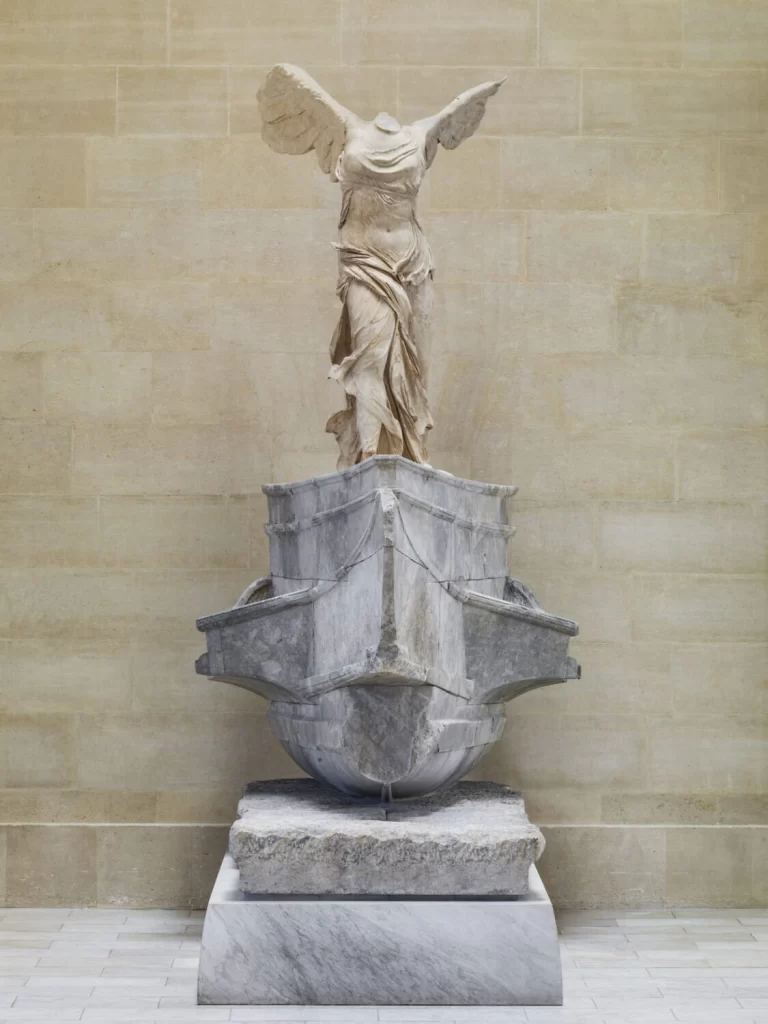



What Amenities Are in Place for Kids at the Louvre?
The Louvre might seem overwhelming for families at first, but it’s surprisingly well-prepared for younger visitors. From creative workshops to strollers and kid-friendly rest areas, there are plenty of thoughtful touches that make exploring this museum enjoyable for everyone.
The Studio and Creative Workshops
For a more interactive experience, head to The Studio (L’Atelier du Louvre), a dedicated space for families. It is located on the ground floor of the Richelieu wing.
- Some activities can be done independently, like board games, reading, and giant colouring.
- There are also family workshops here, but they are only available in French.
- You can find a list of family guided tours here, all in French too. (12.00€ for adults and 9.00€ for children).
Le Petit Louvre: The Online Space for Kids
Before your trip, explore Le Petit Louvre, the museum’s interactive online platform for children aged 7 to 12 years old.
It’s full of short stories, mini-tours, and games that introduce art history in a fun way.
Kids can:
- Access to treasure hunts to do in the museum and the Tuileries Garden.
- Watch short animated clips in English or French with subtitles.
- Try your hand at art and crafts.
- Try recipes
- Play art games and quizzes.
Visit: https://petitlouvre.louvre.fr
Facilities and Services for Families
The Louvre provides several helpful amenities for families visiting with children:
- Free strollers and baby carriers are available at the Welcome Desk under the Pyramid.
- Changing tables are in most restrooms.
- Lockers for storing coats and snacks.
- Elevators for easy access with strollers.
- Restaurants and cafés with child-friendly meals and highchairs (Café Mollien and Café Pyramid).
Pro tip: A baby carrier is often easier to manage than a stroller during busy hours, especially in the Denon Wing.
After Your Visit: Family Fun Nearby
Once you’ve finished exploring, step outside into the Tuileries Garden, a beautiful park just next to the Louvre.
Kids can:
- Play at the playground for free.
- Ride on the carousel or on the trampolines. €3 per ride.
- Go on a treasure hunt from the “Petit Louvre” website.
- Rent a small wooden sailboat to float in the Octagonal Grand Basin (central alley), a tradition since 1850! €6 per rental.
Make the most of your visit by familiarising the children with the museum rules. Come a little earlier to use the locker and restrooms before starting your visit. And bring notebooks and crayons for them to replicate the paintings (on their notebooks, not the walls).
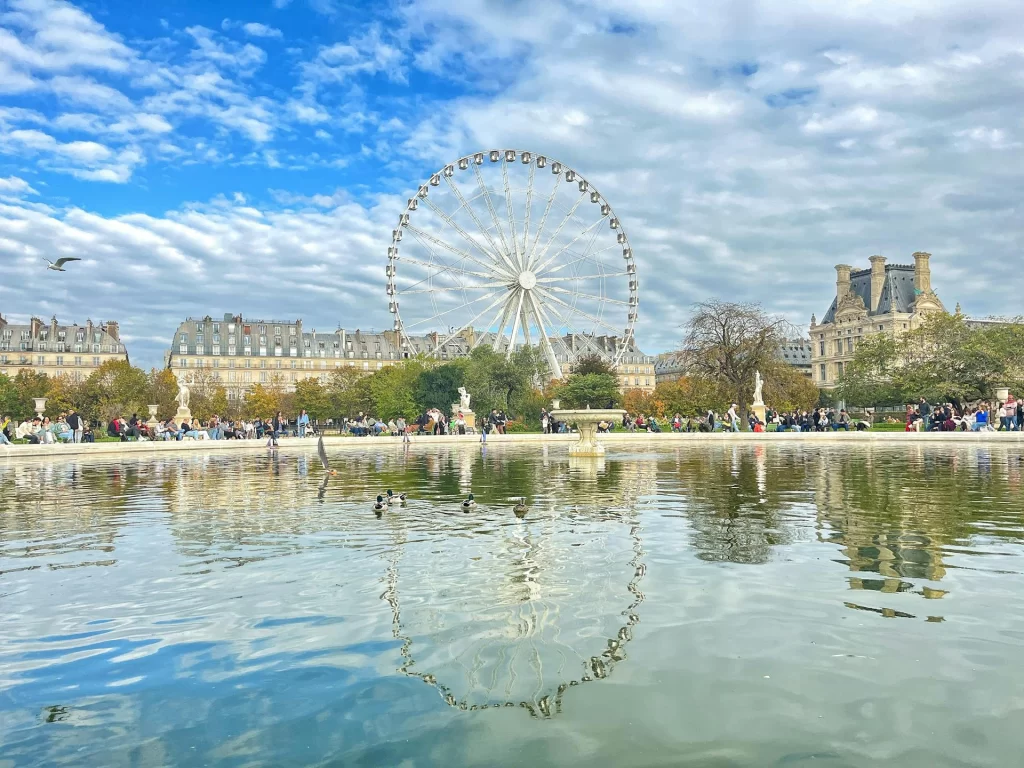
Where to Rest or Eat Near the Louvre?
After a few hours exploring the Louvre’s galleries, you’ll need a pause. Whether you want a quick coffee, a relaxed family lunch, or just a quiet place to rest, there are plenty of good options both inside and around the museum.
Cafés and Restaurants Inside the Louvre
If you prefer to stay within the museum complex, the Louvre has a few cafés and restaurants where you can take a break without leaving the site.
- Café Mollien: Perched above the Denon Wing staircase, this elegant café offers a lovely view over the Cour Napoléon. Perfect for coffee, pastries, or a light salad after visiting the Mona Lisa. It has
access for people with reduced mobility and highchairs. - Café Marly: The most famous one, located under the arcades of the Richelieu Wing, facing the glass Pyramid. It’s chic and pricey but worth it for the atmosphere and view. Plugs for charging phones are available here.
- Café Pyramide: Situated near the main entrance under the glass Pyramid, ideal for a quick coffee or snack. This one has plugs for charging phones and highchairs.
- Boulangerie du Louvre: A great choice for sandwiches, quiches, and fresh pastries, especially if you’re visiting with kids and need something simple. Access for people with reduced mobility.
- Le Louvre Takeaway Counter: For those in a hurry, grab a drink or snack to enjoy on a bench in the Tuileries or along the Seine.
Tip: Seating fills up quickly around noon. Go early for lunch or plan a late afternoon break.
Restaurants and Cafés in the Tuileries Garden
Just outside the museum, the Jardin des Tuileries offers a more relaxed way to enjoy a meal surrounded by greenery and sculptures. It’s one of my favourite places to unwind after a long museum visit.
- Café des Marronniers: A shaded terrace under the trees, and quite pricey. It offers a kids’ menu and is equipped with highchairs. Peaceful and quintessentially Parisian.
- La Terrasse de Pomone: Casual and family-friendly, with light meals, ice cream, crêpes, and snacks. It’s great for a short break or a sweet treat.
- Eric Kayser Tuileries: A well-known Parisian bakery with freshly baked bread, quiches, sandwiches, and pastries. Perfect for a picnic.
- Petit Plisson aux Tuileries: Serves seasonal, locally sourced food and great coffee in a stylish outdoor setting.
If you’re visiting with kids, these spots tend to be more forgiving of the occasional art-inspired meltdown.
Sweet Treats
For a sweet ending (especially with children), don’t miss:
- Angelina Paris (226 Rue de Rivoli): A Parisian institution known for rich hot chocolate and the legendary Mont-Blanc dessert.
- Happy Caffé (214 Rue de Rivoli): a friendly, affordable spot. They serve homemade sweet pancakes and pastries.
It’s the perfect way to end your Louvre day on a Parisian note; simple, relaxed, and delicious.
Final Thoughts
The Louvre will always hold a special place in my heart. My first visit as a student is what first sparked my love for art. Returning as an adult, I see it not just as a museum but as a place that connects history, beauty, and emotion.
Visiting the Louvre doesn’t have to be overwhelming. Whether it’s your first visit or your fifth, go with curiosity, not a checklist. Don’t try to see everything in one day.
